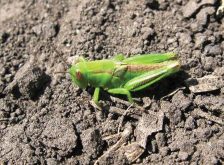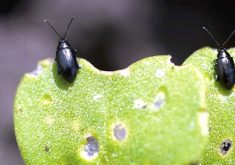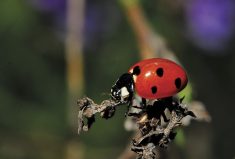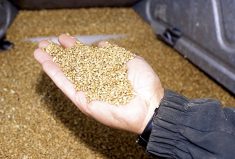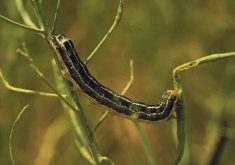Joe Ripley knew something was up in his wheat field — but he had no idea what.
“We just had patches where it was very poor quality and there was hardly anything there,” said the grain and cattle producer from the Spring Coulee area in southern Alberta. “We didn’t realize what it was for a couple of years.”
That first year he wondered if there was a problem with an input, poor germination or maybe some sort of agronomic issue.
“That’s the problem. There are so many issues that can cause a lost crop,” he said.
Read Also

Mosquito-borne virus could be devastating to sheep breeding operations
Cache Valley virus, a mosquito-borne disease that infects small ruminants, could be a devastating hit to small operations.
But when the wheat was patchy in the same spot for a second year, Ripley consulted his local agronomist.
“Initially, it was just one field where it was bad enough that we really noticed it,” he said. “That field is still really bad, and we’re starting to see it spread to a lot of other acres.
“I do a lot of custom farming as well, and I’m even noticing the wireworm in pretty much all the acres that I deal with to some degree.”
Ripley’s ‘what’s going on?’ encounter with wireworms is not unusual.
“There is no official wireworm monitoring program, so it all depends on word of mouth, or impressions farmers have, if they have a wireworm problem or not,” said Haley Catton, research scientist in field crop entomology with Agriculture and Agri-Food Canada in Lethbridge.
Crop thinning in the spring could be a sign of wireworms, but it could also be something else.
“You don’t really know if it’s wireworms unless you go digging around and find the wireworms themselves,” she said.

Damage varies, some fields see major losses while others have minor amounts.
“It puts farmers in a tough spot because these insects are so hard to monitor that they don’t know if they have a problem or not unless it is really severe,” said Catton.
Since he first discovered them five or six years ago, Ripley has upped his seeding rate.
“The first couple of years before we did anything to try and mitigate it, we were seeing probably 20 per cent yield loss in our fields,” he said. “They were very patchy fields, with generally 15 to 20 per cent yield loss on a bad wireworm field.”
Scouting has proven tricky.
“When the plants are young, there will be dead ones, and half-dead ones, and you start digging in the root, and you start finding worms,” he said. “You’re always checking fields. In some fields, we go to check and we find wireworms, in a field that we didn’t think was a problem yet.”
Ripley has tried several products that are supposed to kill the pest, or make them lethargic, but he hasn’t found one that has made a major difference yet.
That doesn’t surprise Catton, who said there are few ways to control them or reduce the damage they cause. Everything in the wireworm world is complicated, starting with the insects themselves, she added.
“Wireworms aren’t worms at all. They’re the larval stage of a beetle called the click beetle,” she said.
Click beetles are native to the Prairies and there’s a whole bunch of different species, each one with different life cycles and behaviours.
“In general, we’re talking about a beetle that is active for only a few weeks in the spring, that lays eggs that will hatch in the soil,” said Catton. “That’s where the wireworms will hatch and live in the soil for three to five years average.”
When the larvae are big or old enough, they will pupate and stay dormant as beetles until the next spring.
“They are a long-lived pest, so if you have them in your field, they’re going to be there year after year after year.”

The only control right now is a chemical seed treatment, and it isn’t working very well, Catton added.
“Until recently, some of the chemicals have subdued them. There are some that may be able to reduce the population, but we still need more data to know that for sure.”
There’s also a lot of variety between different species.
“Some of the species are all female as adults, so they don’t need to mate to lay eggs,” she said. “Some of them can live one year in the soil, some of them can live up to 11 years in the soil.”
Damage to the plants will show up in the early season, when the plants are seedlings. Farmers will start to notice thin sections in their crops.
“I always recommend going to the edges of those patches, and start digging the soil with a trowel to see if you can find wireworms feeding on those plants,” said Catton. “Don’t go to the middle of the patch because if the plants are gone, the wireworms will move away from them. If you go to the edge of the patch, where the plants are still there, that’s where you will find them.”
Also, make sure that thin patches are caused by wireworms, not cutworms, because there are treatment options available for cutworms.
“You can spray for cutworms, but you can’t spray for wireworms in season,” she said.
Wireworms will eat barley, pulses, root crops (such as potatoes and carrots), but seem to do the most damage in wheat.
“Farmers have been really frustrated with the insect over the years, because until recently, they haven’t had any chemicals that could remove them. And because they are long lived, if you have a problem one year, you will have a problem the year after and the year after.”
Better monitoring is needed to understand the pest and this will be the focus of Catton’s research for the next few years.
She is one of the authors of a comprehensive new guide on wireworms. The 86-page guide has information on life cycles, species found on the Prairies, monitoring (including trapping techniques), management options and a host of photos. It can be downloaded in a PDF format at the Government of Canada website. For a print copy, email [email protected].




